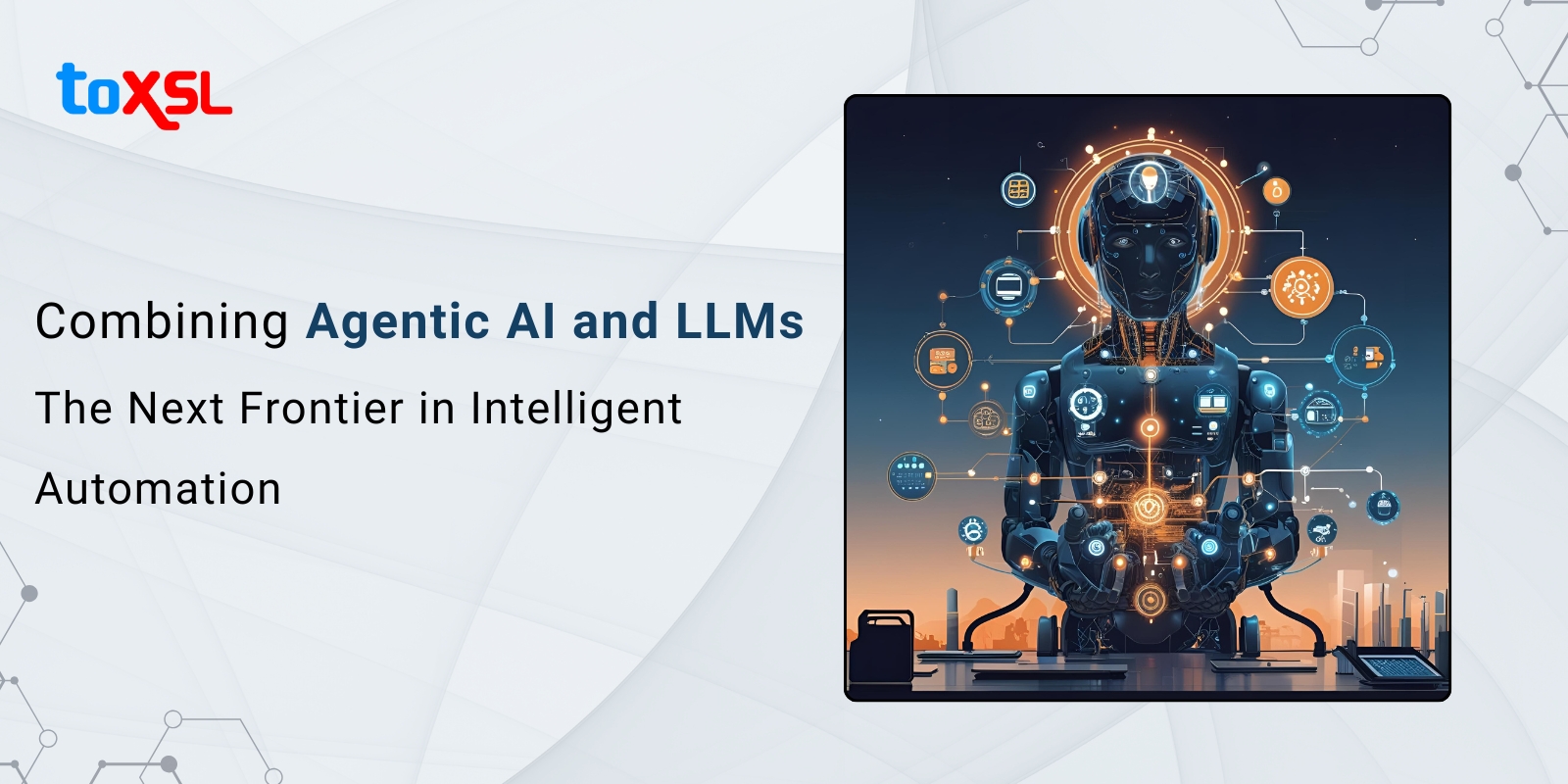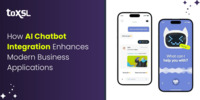- Nov 19, 2025
Share this post on:

Did you know that Agentic AI boosts autonomous decision-making efficiency by 35% and reduces task time by 86%? By 2029, Agentic AI will handle 80% of customer issues, reducing costs by 30%.
The statistics make it clear that Artificial Intelligence has reached its inflection point. Businesses are not limited to training AI models and predicting outputs. We saw AI rising from simple tasks to Generative AI to Agentic AI. It's been a while, but Agentic AI has become one of the hottest topics among businesses and is a revolutionary step beyond static models.
Combining Agentic AI and Large Language Models (LLMs) shows a groundbreaking advancement in intelligent automation, revolutionizing how machines understand, reason, decide, and act autonomously. This integration of Agentic AI and LLMs unites the contextual intelligence and natural language capabilities of LLMs with the autonomous, goal-directed, and adaptive capabilities of Agentic AI systems. Let us go deeper into the blog and learn more about Agentic AI.
Core strengths of combining Agentic AI with LLMs include:
Let us dig into the core strengths of integrating Agentic AI with LLMs:
Contextual and Personalized Decision Making:
Agentic AI systems use LLMs’ ability to understand natural language contextually, enabling them to interpret user intent, maintain memory of past interactions, and dynamically adjust their actions. This leads to personalized, precise responses and decisions tailored to user preferences and situational nuances.
Multi-Agent Collaboration and Complex Task Automation:
Multiple AI agents, each specialized in a task (e.g., data analysis, decision-making, execution), can collaborate, share knowledge, and autonomously manage multi-step workflows. LLMs act as orchestrators, interpreting complex goals and coordinating agentic actions, enhancing system scalability and robustness.
Continuous Learning and Adaptability:
Integrated feedback loops and memory allow these AI systems to learn from interactions and performance data, refining their strategies over time. This continuous learning enhances accuracy, relevance, and alignment with evolving business or user needs.
Enhanced Real-Time Autonomy:
Combining LLMs with agentic AI enables real-time, autonomous decision-making without constant human oversight. Agents can adapt their behavior based on incoming data and contextual changes, making them suitable for fast-paced, dynamic environments such as finance, healthcare, and e-commerce.
Practical applications demonstrate the transformative potential of this integration:
Virtual Assistants with Memory:
Agentic AI-powered assistants excel at scheduling, managing tasks, and recalling past conversations to maintain seamless interactions. LLMs empower these agents to understand nuanced instructions and engage naturally with users.
Customer Service Automation:
Combining LLMs' language skills with agentic reasoning yields bots that resolve queries independently, learn from historical interactions, and personalize support, reducing human workload and enhancing customer satisfaction.
Autonomous Research and Data Analysis Bots:
These can autonomously browse, analyze, and summarize vast information sources, guided by complex, contextually rich LLM prompts, expediting research processes.
Dynamic Workflow Management:
Agentic AI systems adapt production scheduling, supply chain management, or marketing strategies in real time, leveraging LLM insights to optimize decisions across complex operational domains.
Looking forward, the integration between agentic AI and LLMs foretells a future where:
- AI agents engage in multimodal interactions, integrating text, speech, and visual inputs for richer and more natural user experiences.
- Multiple agents collaborate within ecosystems, sharing goals, memory, and learning, enabling collective problem-solving and task execution at new scales.
- Systems continuously self-improve, adapting behaviors and strategies through sophisticated learning mechanisms and LLM fine-tuning.
This emerging paradigm transcends traditional automation by bestowing machines with the ability to think, communicate, and act autonomously in human-centric ways, driving efficiency, innovation, and user engagement across industries.
Why Combine Agentic AI and LLMs?
Here are the benefits of combining Agentic AI with LLMs:
Enhanced Contextual Intelligence: LLMs are good at processing natural language and understanding contextual cues. When embedded in an Agentic system, AI agents gain the ability to interpret complex instructions, understand user intent, and maintain conversational context over time. This leads to conversations that sound more human-like.
Multi-Stage Decision Making and Planning: Agentic AI allows AI systems to break complex tasks into smaller steps. Plan sequences and recognize actions dynamically based on feedback or changing objectives. LLMs guide the entire process with flexible understanding and reasoning.
Real-time Customization and Adaptation: Agentic AI and LLM enable customization at scale. It remembers user preferences, adapts decision rules to fly, and offers customized outputs, enhancing user satisfaction and operational efficiency.
Autonomous and Scalable Automation: Agentic LLMs empower agents to work independently without human intervention, handling large workloads across and transforming user satisfaction and user interactions.
Benefits of Integrating Agentic AI and LLMs
The benefits of combining Agentic AI and Large Language Models (LLM) result in numerous advantages, including:
Customized Decision-Making: LLMs offer natural language understanding and allow Agentic systems to interpret user intent, maintain memory of past interactions, and adapt responses and actions. This leads to highly customized, precise, and context-aware decisions customized to user requirements.
Multi-step Execution: Agentic AI allows autonomous planning, reasoning, and action across multi-stage workflows. While LLMs guide these processes with flexible contextual reasoning. This ensures the reliable execution of tasks with minimal human oversight.
Continuous Learning and Adaptability: Integration of LLMs and Agentic AI allows agents to self-improve decision strategies and operational effectiveness over time.
Natural and Intuitive Communication: LLM’s natural language generation increases user engagement by enabling smooth and human-like conversations.
Cost Reduction and Efficiency Gain: These systems automate routine to complex cognitive workflows autonomously and integrate systems to reduce manual labor, lower operational costs, improve task accuracy, and speed up processes.
Enhanced Real-time Responsiveness: Agentic AI with LLMs can adapt decisions and actions rapidly based on real-time data and evolving objectives, making them suitable for dynamic environments requiring fast, informed responses.
Robust Decision-Making: Incorporation of advanced decision-making frameworks with probabilistic and rule-based models allows agentic AI systems to weigh alternatives and optimize actions effectively, further empowered by the reasoning ability of LLMs.
Future Directions and Challenges
The integration of Agentic AI with LLMs is poised to deepen with advances in multimodal AI, enhanced agent collaboration frameworks, and improved self-learning mechanisms. However, challenges remain:
Ethical and Responsible Use: Autonomous decision-making requires robust frameworks to guarantee fairness, transparency, privacy, and accountability.
Complexity: Coordinating many autonomous agents with real-time data demands sophisticated orchestration and error handling.
Security: Securing Autonomous agents must be safeguarded against malicious inputs and vulnerabilities to prevent unintended actions.
Computational Resources: High-performance systems are needed to run numerous interacting agents and large LLMs efficiently.
Conclusion:
In conclusion, to realize the full promise of this next generation of intelligent automation, continued research and development, and thoughtful governance are necessary. Combining Agentic AI and LLMs not only gives incremental improvement, but it is a whole shift toward intelligent systems that think, communicate, decide, and act autonomously.
This integration unlocks automation possibilities, transforming how businesses work and how humans interact with machines. Want to learn more about Agentic AI and LLMs? ToXSL Technologies is here to help. As a leading Artificial Intelligence services provider company, we have successfully offered a lot of AI solutions to businesses globally. So, what are you waiting for? Contact us today to learn more.
Frequently Aked Questions:
1. What is Agentic AI and how does it differ from traditional AI?
Agentic AI refers to systems that act autonomously with initiative and adaptability, capable of planning, decision-making, and learning over time. Unlike traditional AI, which often reacts or follows preset rules, agentic AI behaves like an independent agent working toward goals in complex environments, often coordinating multiple specialized AI components including LLMs.
2. How do Large Language Models (LLMs) enhance Agentic AI?
LLMs provide advanced natural language understanding and generation, enabling agentic AI systems to interpret complex instructions, maintain conversational context, reason flexibly, and communicate naturally with humans or other agents. This grants the combined system richer contextual intelligence and nuanced interaction abilities.
3. What practical benefits arise from combining Agentic AI with LLMs?
Combining these technologies enables autonomous multi-step task execution, continuous learning and adaptation, real-time personalized decisions, natural user engagement, cross-domain flexibility, and operational efficiency gains. This synergy supports complex workflows with less human oversight and smarter, context-aware automation.
4. In what real-world scenarios are Agentic AI and LLM integration most valuable?
They are especially useful in virtual assistants with memory, customer service automation, autonomous research and data analysis, dynamic workflow management, healthcare monitoring, supply chain optimization, and financial services automation—any domain requiring complex, context-rich decision-making and communication.
5. What are the main challenges in developing and deploying Agentic AI with LLMs?
Challenges include ensuring ethical use, managing complexity in agent coordination and error handling, securing systems against malicious inputs, and meeting the high computational resource demands of running large models and multiple interacting agents effectively












